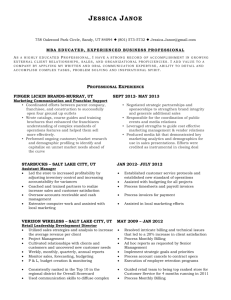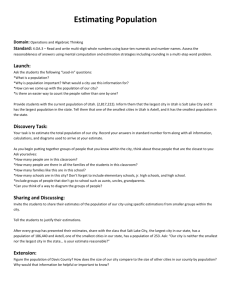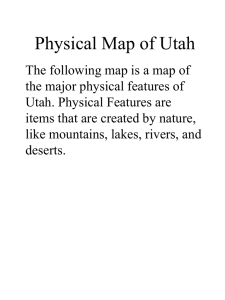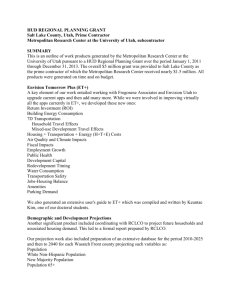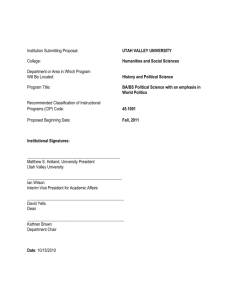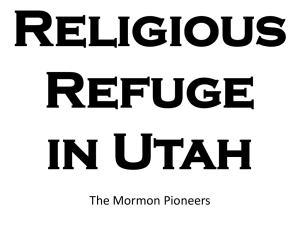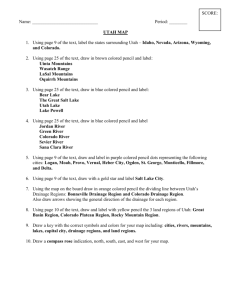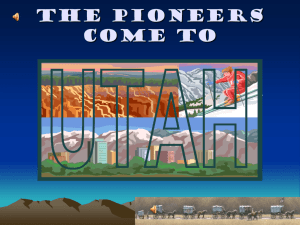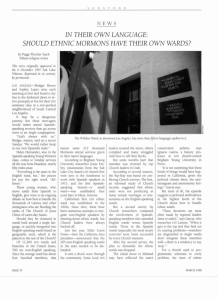THE MOUNTAIN STATES
advertisement
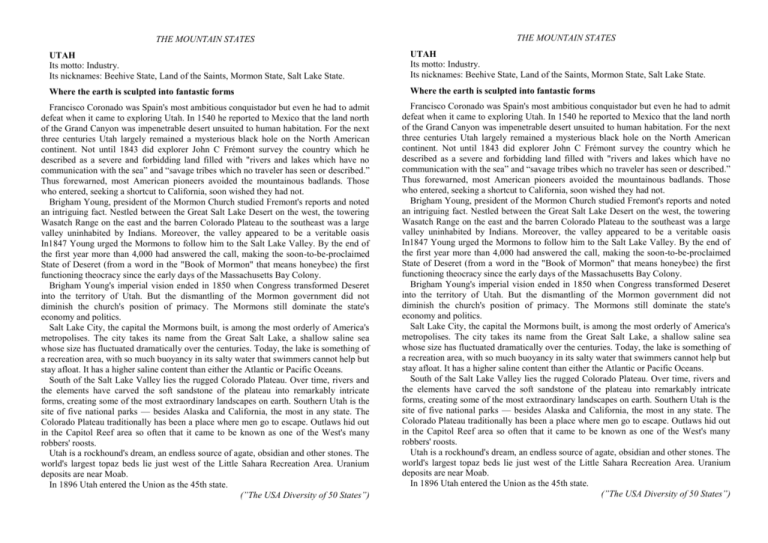
THE MOUNTAIN STATES THE MOUNTAIN STATES UTAH Its motto: Industry. Its nicknames: Beehive State, Land of the Saints, Mormon State, Salt Lake State. UTAH Its motto: Industry. Its nicknames: Beehive State, Land of the Saints, Mormon State, Salt Lake State. Where the earth is sculpted into fantastic forms Where the earth is sculpted into fantastic forms Francisco Coronado was Spain's most ambitious conquistador but even he had to admit defeat when it came to exploring Utah. In 1540 he reported to Mexico that the land north of the Grand Canyon was impenetrable desert unsuited to human habitation. For the next three centuries Utah largely remained a mysterious black hole on the North American continent. Not until 1843 did explorer John C Frémont survey the country which he described as a severe and forbidding land filled with "rivers and lakes which have no communication with the sea” and “savage tribes which no traveler has seen or described.” Thus forewarned, most American pioneers avoided the mountainous badlands. Those who entered, seeking a shortcut to California, soon wished they had not. Brigham Young, president of the Mormon Church studied Fremont's reports and noted an intriguing fact. Nestled between the Great Salt Lake Desert on the west, the towering Wasatch Range on the east and the barren Colorado Plateau to the southeast was a large valley uninhabited by Indians. Moreover, the valley appeared to be a veritable oasis In1847 Young urged the Mormons to follow him to the Salt Lake Valley. By the end of the first year more than 4,000 had answered the call, making the soon-to-be-proclaimed State of Deseret (from a word in the "Book of Mormon" that means honeybee) the first functioning theocracy since the early days of the Massachusetts Bay Colony. Brigham Young's imperial vision ended in 1850 when Congress transformed Deseret into the territory of Utah. But the dismantling of the Mormon government did not diminish the church's position of primacy. The Mormons still dominate the state's economy and politics. Salt Lake City, the capital the Mormons built, is among the most orderly of America's metropolises. The city takes its name from the Great Salt Lake, a shallow saline sea whose size has fluctuated dramatically over the centuries. Today, the lake is something of a recreation area, with so much buoyancy in its salty water that swimmers cannot help but stay afloat. It has a higher saline content than either the Atlantic or Pacific Oceans. South of the Salt Lake Valley lies the rugged Colorado Plateau. Over time, rivers and the elements have carved the soft sandstone of the plateau into remarkably intricate forms, creating some of the most extraordinary landscapes on earth. Southern Utah is the site of five national parks — besides Alaska and California, the most in any state. The Colorado Plateau traditionally has been a place where men go to escape. Outlaws hid out in the Capitol Reef area so often that it came to be known as one of the West's many robbers' roosts. Utah is a rockhound's dream, an endless source of agate, obsidian and other stones. The world's largest topaz beds lie just west of the Little Sahara Recreation Area. Uranium deposits are near Moab. In 1896 Utah entered the Union as the 45th state. (”The USA Diversity of 50 States”) Francisco Coronado was Spain's most ambitious conquistador but even he had to admit defeat when it came to exploring Utah. In 1540 he reported to Mexico that the land north of the Grand Canyon was impenetrable desert unsuited to human habitation. For the next three centuries Utah largely remained a mysterious black hole on the North American continent. Not until 1843 did explorer John C Frémont survey the country which he described as a severe and forbidding land filled with "rivers and lakes which have no communication with the sea” and “savage tribes which no traveler has seen or described.” Thus forewarned, most American pioneers avoided the mountainous badlands. Those who entered, seeking a shortcut to California, soon wished they had not. Brigham Young, president of the Mormon Church studied Fremont's reports and noted an intriguing fact. Nestled between the Great Salt Lake Desert on the west, the towering Wasatch Range on the east and the barren Colorado Plateau to the southeast was a large valley uninhabited by Indians. Moreover, the valley appeared to be a veritable oasis In1847 Young urged the Mormons to follow him to the Salt Lake Valley. By the end of the first year more than 4,000 had answered the call, making the soon-to-be-proclaimed State of Deseret (from a word in the "Book of Mormon" that means honeybee) the first functioning theocracy since the early days of the Massachusetts Bay Colony. Brigham Young's imperial vision ended in 1850 when Congress transformed Deseret into the territory of Utah. But the dismantling of the Mormon government did not diminish the church's position of primacy. The Mormons still dominate the state's economy and politics. Salt Lake City, the capital the Mormons built, is among the most orderly of America's metropolises. The city takes its name from the Great Salt Lake, a shallow saline sea whose size has fluctuated dramatically over the centuries. Today, the lake is something of a recreation area, with so much buoyancy in its salty water that swimmers cannot help but stay afloat. It has a higher saline content than either the Atlantic or Pacific Oceans. South of the Salt Lake Valley lies the rugged Colorado Plateau. Over time, rivers and the elements have carved the soft sandstone of the plateau into remarkably intricate forms, creating some of the most extraordinary landscapes on earth. Southern Utah is the site of five national parks — besides Alaska and California, the most in any state. The Colorado Plateau traditionally has been a place where men go to escape. Outlaws hid out in the Capitol Reef area so often that it came to be known as one of the West's many robbers' roosts. Utah is a rockhound's dream, an endless source of agate, obsidian and other stones. The world's largest topaz beds lie just west of the Little Sahara Recreation Area. Uranium deposits are near Moab. In 1896 Utah entered the Union as the 45th state. (”The USA Diversity of 50 States”)
